Transforming Traditional Legal-Centric Approach to Customer-Centric Mindset
VerifiedAdded on 2023/06/11
|15
|3315
|340
AI Summary
This business report discusses the decision to transform the traditional legal-centric approach to a customer-centric mindset in Clayton UTZ. It addresses the issues and models for adopting a customer-centric approach, as well as the functions of management, decision making, and communication. The report concludes that maintaining a relationship with customers is as important as maintaining adequate funds in the business.
Contribute Materials
Your contribution can guide someone’s learning journey. Share your
documents today.
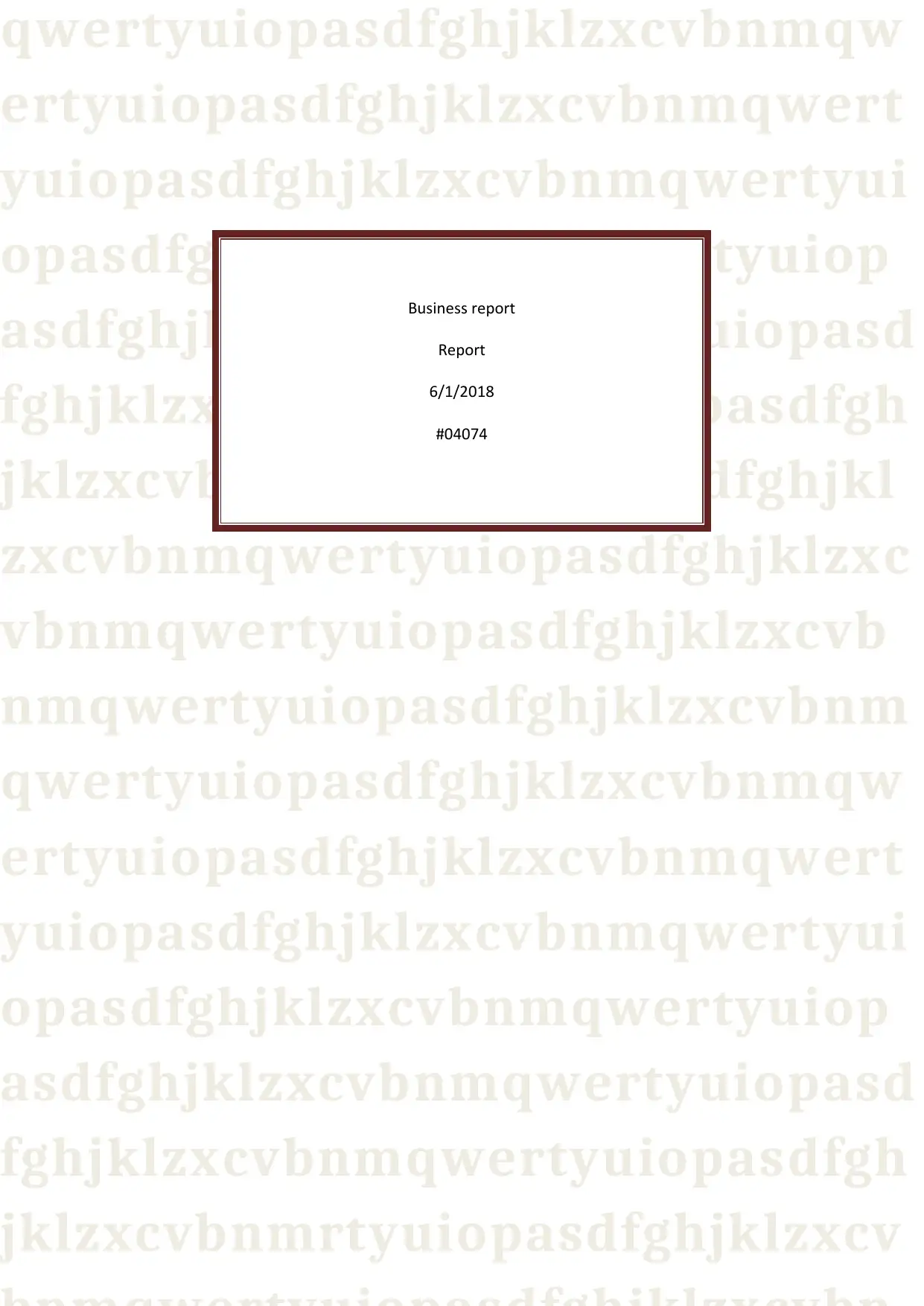
qwertyuiopasdfghjklzxcvbnmqw
ertyuiopasdfghjklzxcvbnmqwert
yuiopasdfghjklzxcvbnmqwertyui
opasdfghjklzxcvbnmqwertyuiop
asdfghjklzxcvbnmqwertyuiopasd
fghjklzxcvbnmqwertyuiopasdfgh
jklzxcvbnmqwertyuiopasdfghjkl
zxcvbnmqwertyuiopasdfghjklzxc
vbnmqwertyuiopasdfghjklzxcvb
nmqwertyuiopasdfghjklzxcvbnm
qwertyuiopasdfghjklzxcvbnmqw
ertyuiopasdfghjklzxcvbnmqwert
yuiopasdfghjklzxcvbnmqwertyui
opasdfghjklzxcvbnmqwertyuiop
asdfghjklzxcvbnmqwertyuiopasd
fghjklzxcvbnmqwertyuiopasdfgh
jklzxcvbnmrtyuiopasdfghjklzxcv
Business report
Report
6/1/2018
#04074
ertyuiopasdfghjklzxcvbnmqwert
yuiopasdfghjklzxcvbnmqwertyui
opasdfghjklzxcvbnmqwertyuiop
asdfghjklzxcvbnmqwertyuiopasd
fghjklzxcvbnmqwertyuiopasdfgh
jklzxcvbnmqwertyuiopasdfghjkl
zxcvbnmqwertyuiopasdfghjklzxc
vbnmqwertyuiopasdfghjklzxcvb
nmqwertyuiopasdfghjklzxcvbnm
qwertyuiopasdfghjklzxcvbnmqw
ertyuiopasdfghjklzxcvbnmqwert
yuiopasdfghjklzxcvbnmqwertyui
opasdfghjklzxcvbnmqwertyuiop
asdfghjklzxcvbnmqwertyuiopasd
fghjklzxcvbnmqwertyuiopasdfgh
jklzxcvbnmrtyuiopasdfghjklzxcv
Business report
Report
6/1/2018
#04074
Secure Best Marks with AI Grader
Need help grading? Try our AI Grader for instant feedback on your assignments.
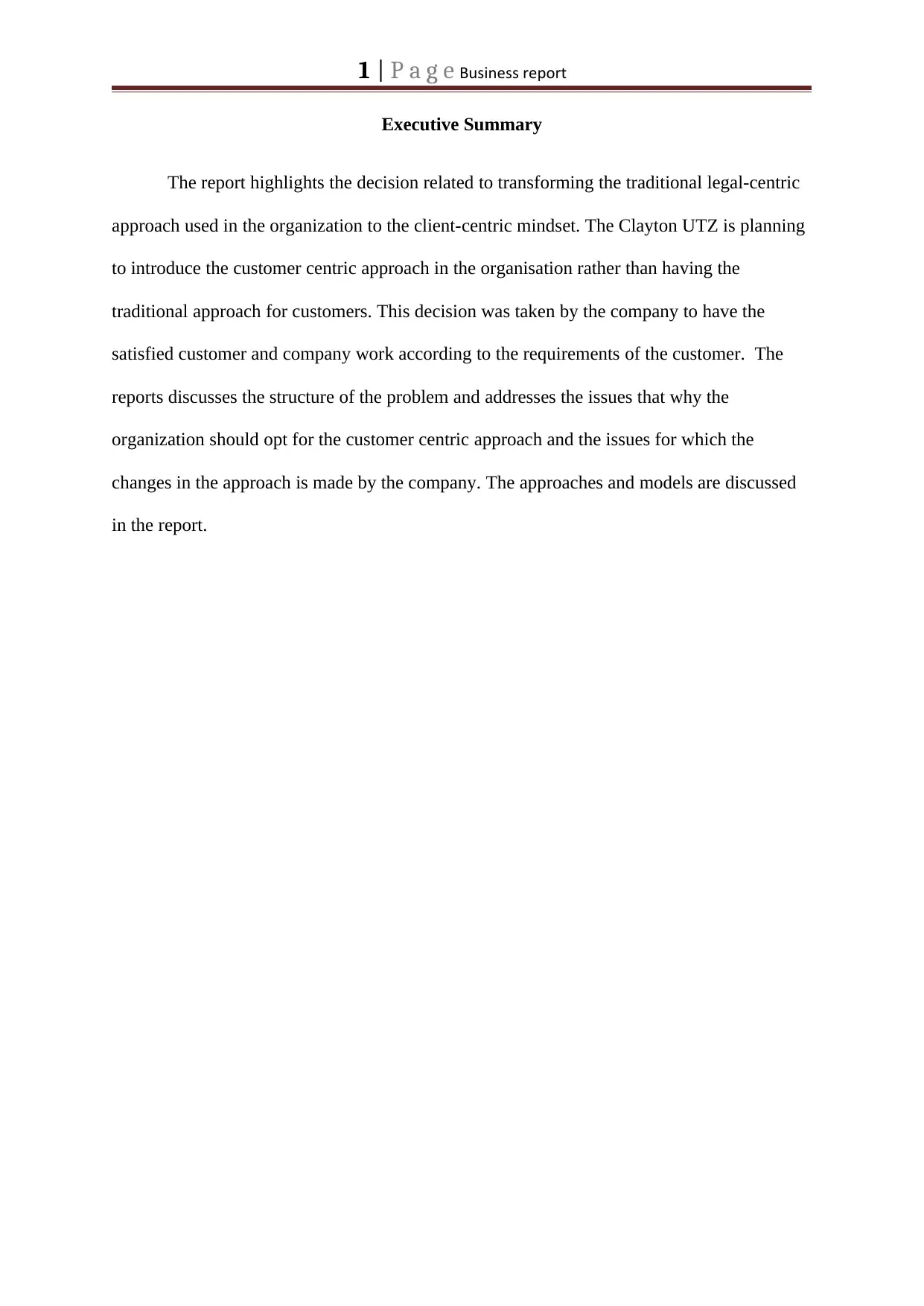
1 | P a g e Business report
Executive Summary
The report highlights the decision related to transforming the traditional legal-centric
approach used in the organization to the client-centric mindset. The Clayton UTZ is planning
to introduce the customer centric approach in the organisation rather than having the
traditional approach for customers. This decision was taken by the company to have the
satisfied customer and company work according to the requirements of the customer. The
reports discusses the structure of the problem and addresses the issues that why the
organization should opt for the customer centric approach and the issues for which the
changes in the approach is made by the company. The approaches and models are discussed
in the report.
Executive Summary
The report highlights the decision related to transforming the traditional legal-centric
approach used in the organization to the client-centric mindset. The Clayton UTZ is planning
to introduce the customer centric approach in the organisation rather than having the
traditional approach for customers. This decision was taken by the company to have the
satisfied customer and company work according to the requirements of the customer. The
reports discusses the structure of the problem and addresses the issues that why the
organization should opt for the customer centric approach and the issues for which the
changes in the approach is made by the company. The approaches and models are discussed
in the report.
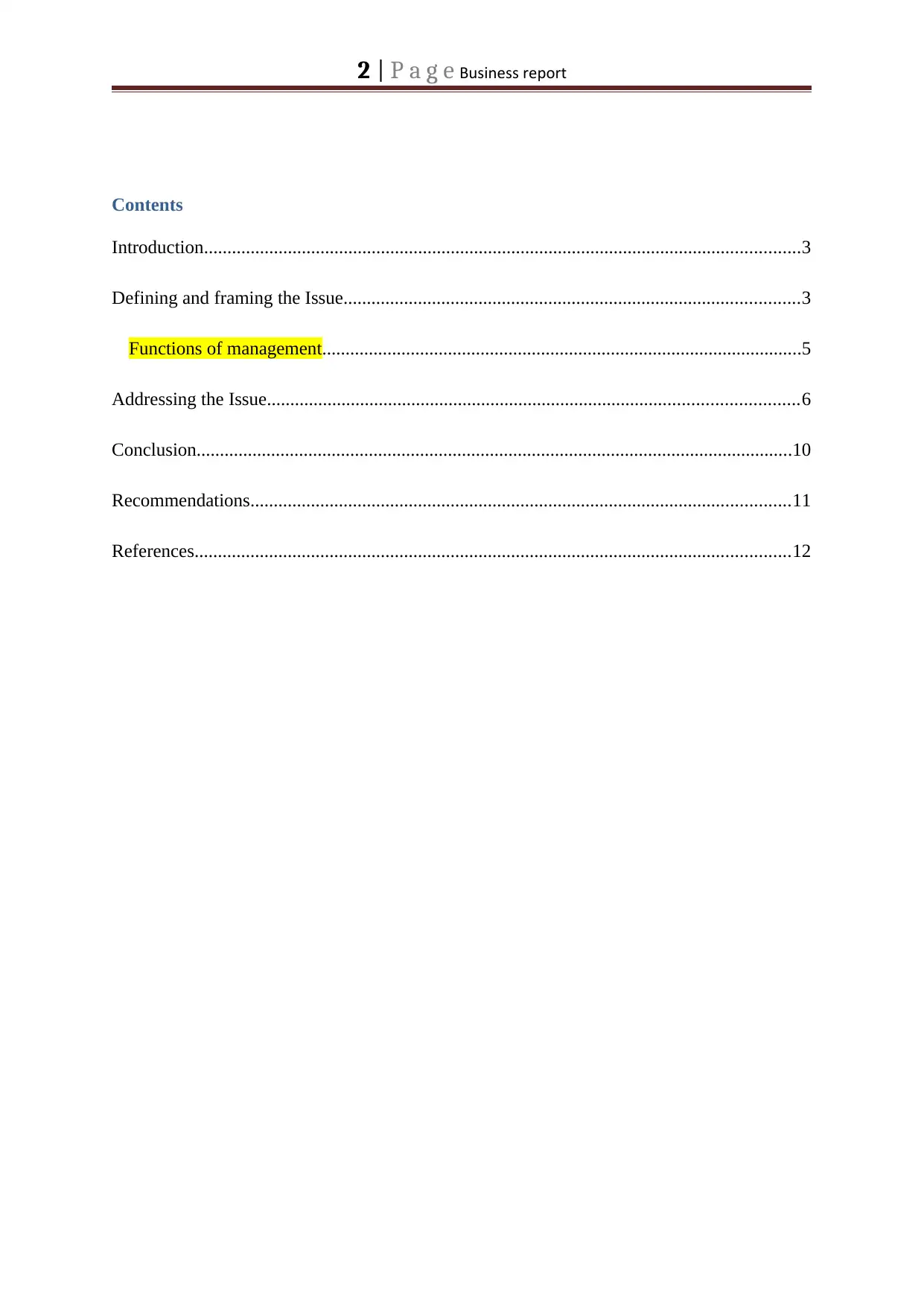
2 | P a g e Business report
Contents
Introduction................................................................................................................................3
Defining and framing the Issue..................................................................................................3
Functions of management.......................................................................................................5
Addressing the Issue..................................................................................................................6
Conclusion................................................................................................................................10
Recommendations....................................................................................................................11
References................................................................................................................................12
Contents
Introduction................................................................................................................................3
Defining and framing the Issue..................................................................................................3
Functions of management.......................................................................................................5
Addressing the Issue..................................................................................................................6
Conclusion................................................................................................................................10
Recommendations....................................................................................................................11
References................................................................................................................................12
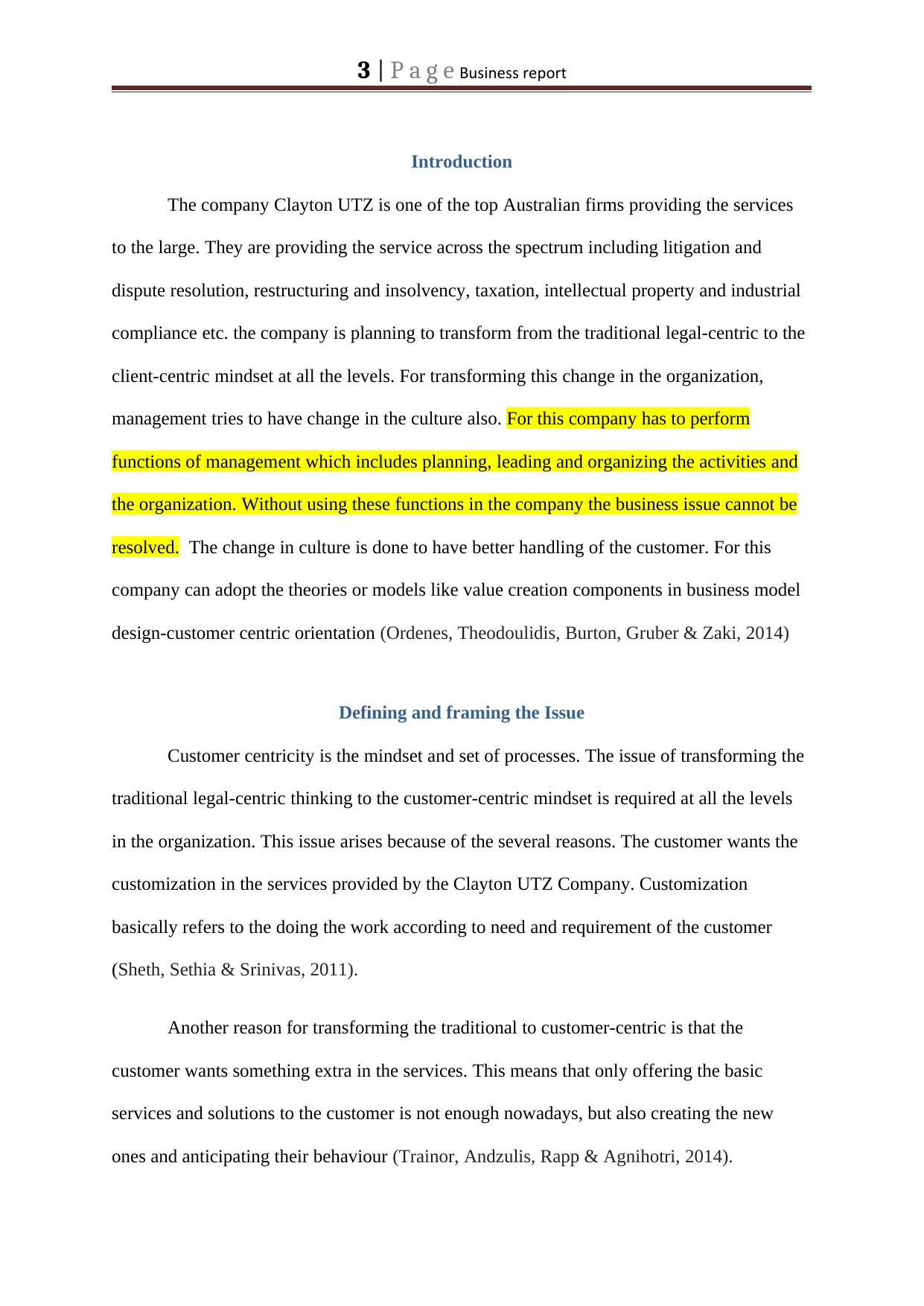
3 | P a g e Business report
Introduction
The company Clayton UTZ is one of the top Australian firms providing the services
to the large. They are providing the service across the spectrum including litigation and
dispute resolution, restructuring and insolvency, taxation, intellectual property and industrial
compliance etc. the company is planning to transform from the traditional legal-centric to the
client-centric mindset at all the levels. For transforming this change in the organization,
management tries to have change in the culture also. For this company has to perform
functions of management which includes planning, leading and organizing the activities and
the organization. Without using these functions in the company the business issue cannot be
resolved. The change in culture is done to have better handling of the customer. For this
company can adopt the theories or models like value creation components in business model
design-customer centric orientation (Ordenes, Theodoulidis, Burton, Gruber & Zaki, 2014)
Defining and framing the Issue
Customer centricity is the mindset and set of processes. The issue of transforming the
traditional legal-centric thinking to the customer-centric mindset is required at all the levels
in the organization. This issue arises because of the several reasons. The customer wants the
customization in the services provided by the Clayton UTZ Company. Customization
basically refers to the doing the work according to need and requirement of the customer
(Sheth, Sethia & Srinivas, 2011).
Another reason for transforming the traditional to customer-centric is that the
customer wants something extra in the services. This means that only offering the basic
services and solutions to the customer is not enough nowadays, but also creating the new
ones and anticipating their behaviour (Trainor, Andzulis, Rapp & Agnihotri, 2014).
Introduction
The company Clayton UTZ is one of the top Australian firms providing the services
to the large. They are providing the service across the spectrum including litigation and
dispute resolution, restructuring and insolvency, taxation, intellectual property and industrial
compliance etc. the company is planning to transform from the traditional legal-centric to the
client-centric mindset at all the levels. For transforming this change in the organization,
management tries to have change in the culture also. For this company has to perform
functions of management which includes planning, leading and organizing the activities and
the organization. Without using these functions in the company the business issue cannot be
resolved. The change in culture is done to have better handling of the customer. For this
company can adopt the theories or models like value creation components in business model
design-customer centric orientation (Ordenes, Theodoulidis, Burton, Gruber & Zaki, 2014)
Defining and framing the Issue
Customer centricity is the mindset and set of processes. The issue of transforming the
traditional legal-centric thinking to the customer-centric mindset is required at all the levels
in the organization. This issue arises because of the several reasons. The customer wants the
customization in the services provided by the Clayton UTZ Company. Customization
basically refers to the doing the work according to need and requirement of the customer
(Sheth, Sethia & Srinivas, 2011).
Another reason for transforming the traditional to customer-centric is that the
customer wants something extra in the services. This means that only offering the basic
services and solutions to the customer is not enough nowadays, but also creating the new
ones and anticipating their behaviour (Trainor, Andzulis, Rapp & Agnihotri, 2014).
Secure Best Marks with AI Grader
Need help grading? Try our AI Grader for instant feedback on your assignments.
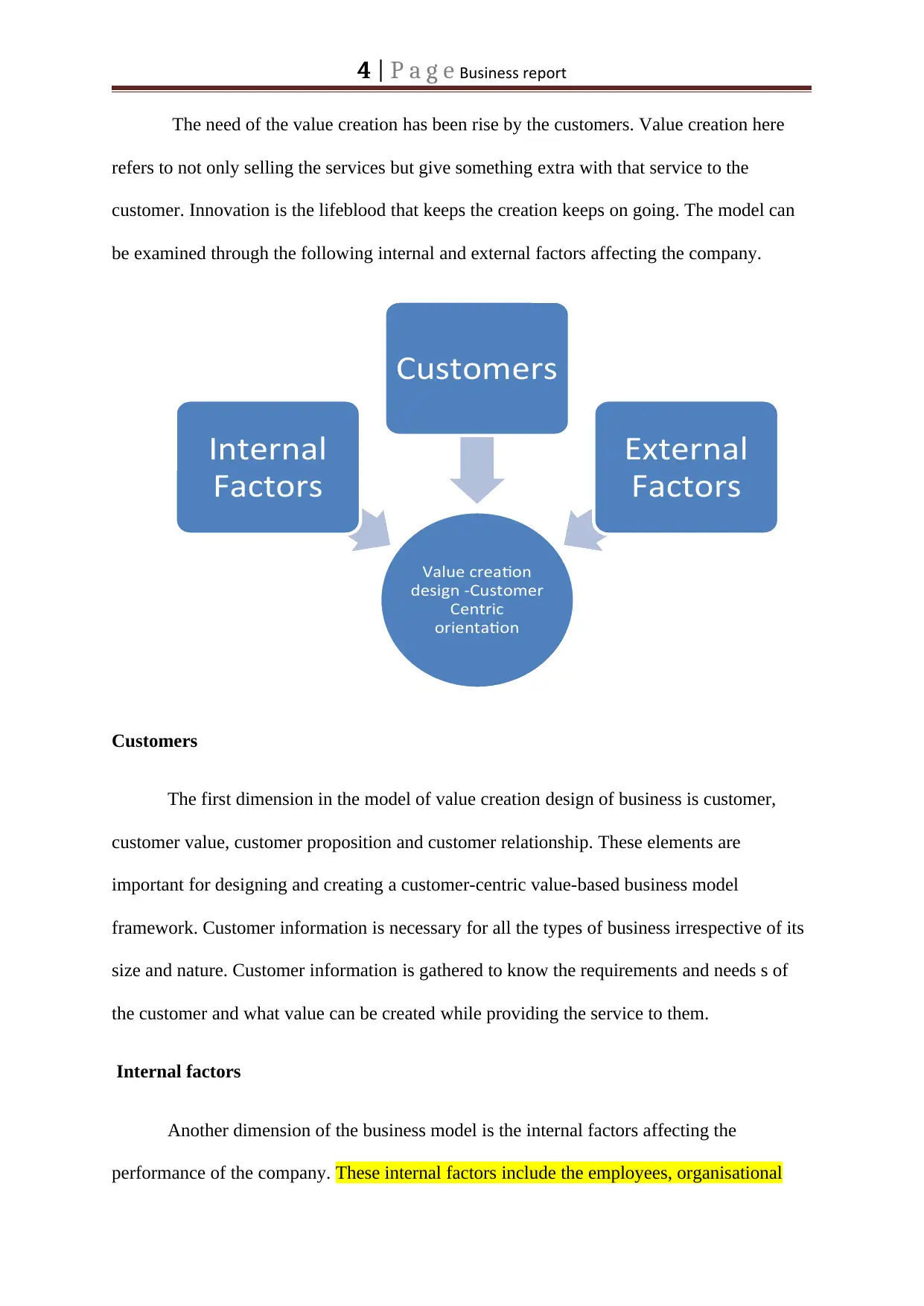
4 | P a g e Business report
The need of the value creation has been rise by the customers. Value creation here
refers to not only selling the services but give something extra with that service to the
customer. Innovation is the lifeblood that keeps the creation keeps on going. The model can
be examined through the following internal and external factors affecting the company.
Customers
The first dimension in the model of value creation design of business is customer,
customer value, customer proposition and customer relationship. These elements are
important for designing and creating a customer-centric value-based business model
framework. Customer information is necessary for all the types of business irrespective of its
size and nature. Customer information is gathered to know the requirements and needs s of
the customer and what value can be created while providing the service to them.
Internal factors
Another dimension of the business model is the internal factors affecting the
performance of the company. These internal factors include the employees, organisational
Value creation
design -Customer
Centric
orientation
Internal
Factors
Customers
External
Factors
The need of the value creation has been rise by the customers. Value creation here
refers to not only selling the services but give something extra with that service to the
customer. Innovation is the lifeblood that keeps the creation keeps on going. The model can
be examined through the following internal and external factors affecting the company.
Customers
The first dimension in the model of value creation design of business is customer,
customer value, customer proposition and customer relationship. These elements are
important for designing and creating a customer-centric value-based business model
framework. Customer information is necessary for all the types of business irrespective of its
size and nature. Customer information is gathered to know the requirements and needs s of
the customer and what value can be created while providing the service to them.
Internal factors
Another dimension of the business model is the internal factors affecting the
performance of the company. These internal factors include the employees, organisational
Value creation
design -Customer
Centric
orientation
Internal
Factors
Customers
External
Factors
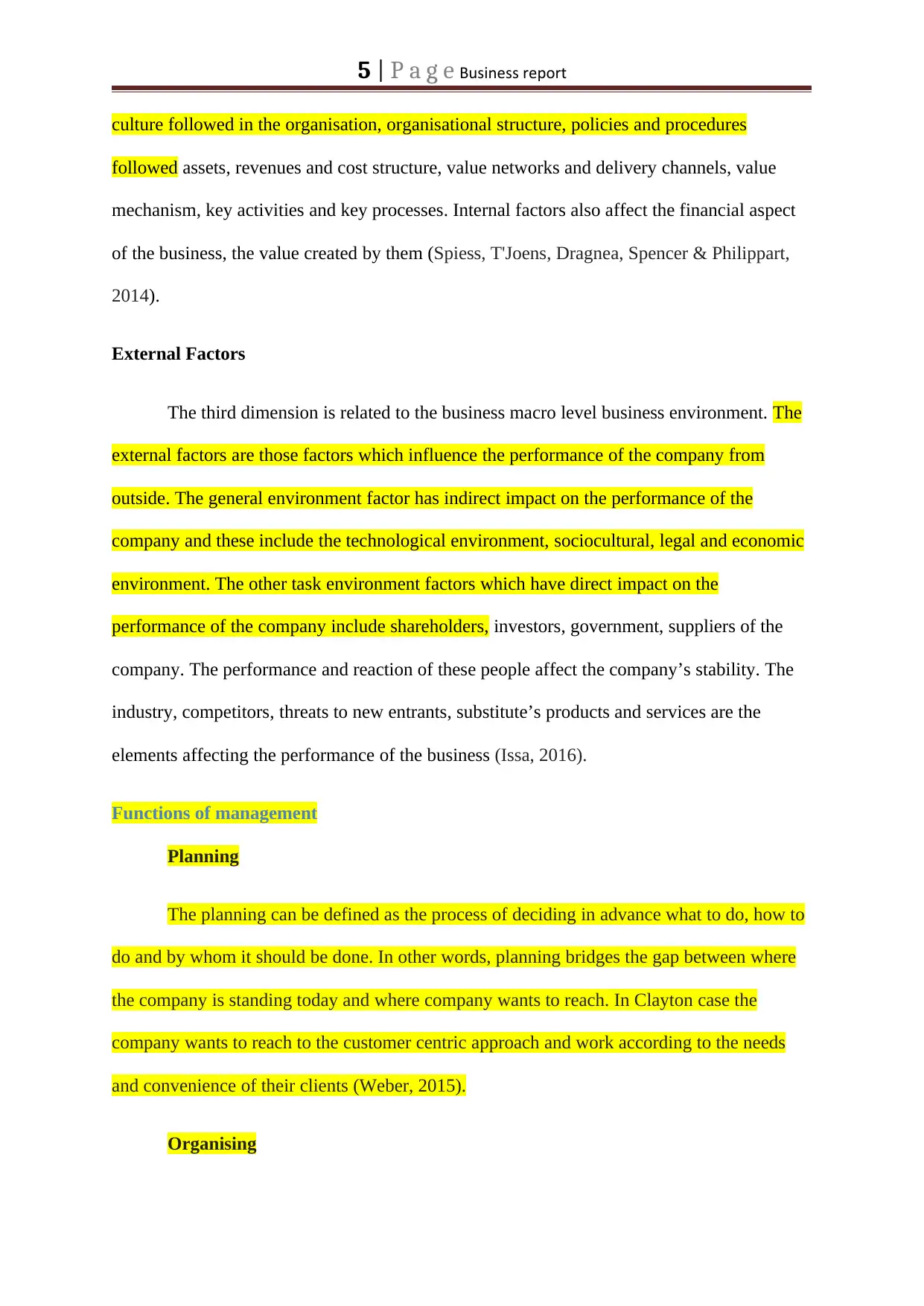
5 | P a g e Business report
culture followed in the organisation, organisational structure, policies and procedures
followed assets, revenues and cost structure, value networks and delivery channels, value
mechanism, key activities and key processes. Internal factors also affect the financial aspect
of the business, the value created by them (Spiess, T'Joens, Dragnea, Spencer & Philippart,
2014).
External Factors
The third dimension is related to the business macro level business environment. The
external factors are those factors which influence the performance of the company from
outside. The general environment factor has indirect impact on the performance of the
company and these include the technological environment, sociocultural, legal and economic
environment. The other task environment factors which have direct impact on the
performance of the company include shareholders, investors, government, suppliers of the
company. The performance and reaction of these people affect the company’s stability. The
industry, competitors, threats to new entrants, substitute’s products and services are the
elements affecting the performance of the business (Issa, 2016).
Functions of management
Planning
The planning can be defined as the process of deciding in advance what to do, how to
do and by whom it should be done. In other words, planning bridges the gap between where
the company is standing today and where company wants to reach. In Clayton case the
company wants to reach to the customer centric approach and work according to the needs
and convenience of their clients (Weber, 2015).
Organising
culture followed in the organisation, organisational structure, policies and procedures
followed assets, revenues and cost structure, value networks and delivery channels, value
mechanism, key activities and key processes. Internal factors also affect the financial aspect
of the business, the value created by them (Spiess, T'Joens, Dragnea, Spencer & Philippart,
2014).
External Factors
The third dimension is related to the business macro level business environment. The
external factors are those factors which influence the performance of the company from
outside. The general environment factor has indirect impact on the performance of the
company and these include the technological environment, sociocultural, legal and economic
environment. The other task environment factors which have direct impact on the
performance of the company include shareholders, investors, government, suppliers of the
company. The performance and reaction of these people affect the company’s stability. The
industry, competitors, threats to new entrants, substitute’s products and services are the
elements affecting the performance of the business (Issa, 2016).
Functions of management
Planning
The planning can be defined as the process of deciding in advance what to do, how to
do and by whom it should be done. In other words, planning bridges the gap between where
the company is standing today and where company wants to reach. In Clayton case the
company wants to reach to the customer centric approach and work according to the needs
and convenience of their clients (Weber, 2015).
Organising
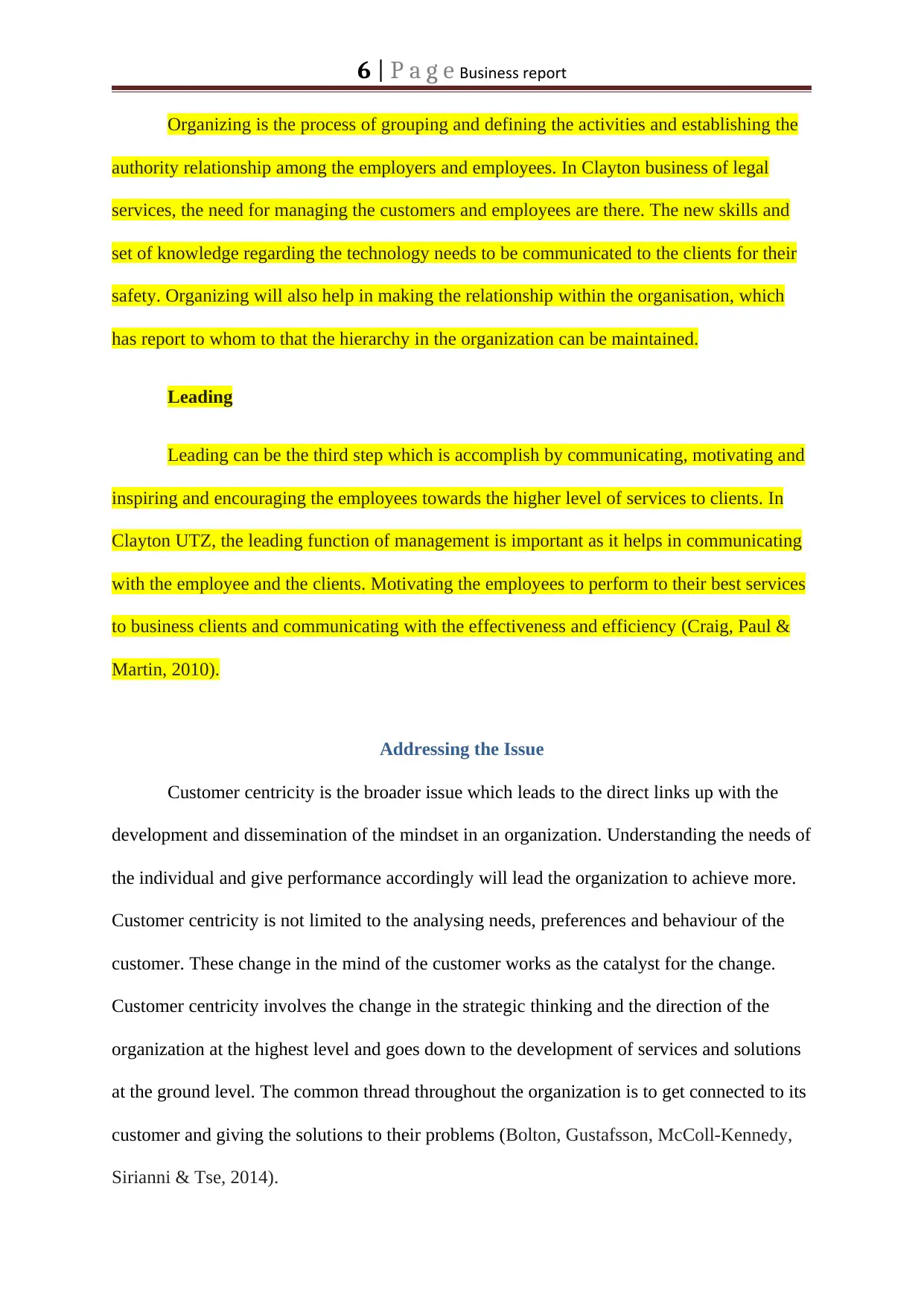
6 | P a g e Business report
Organizing is the process of grouping and defining the activities and establishing the
authority relationship among the employers and employees. In Clayton business of legal
services, the need for managing the customers and employees are there. The new skills and
set of knowledge regarding the technology needs to be communicated to the clients for their
safety. Organizing will also help in making the relationship within the organisation, which
has report to whom to that the hierarchy in the organization can be maintained.
Leading
Leading can be the third step which is accomplish by communicating, motivating and
inspiring and encouraging the employees towards the higher level of services to clients. In
Clayton UTZ, the leading function of management is important as it helps in communicating
with the employee and the clients. Motivating the employees to perform to their best services
to business clients and communicating with the effectiveness and efficiency (Craig, Paul &
Martin, 2010).
Addressing the Issue
Customer centricity is the broader issue which leads to the direct links up with the
development and dissemination of the mindset in an organization. Understanding the needs of
the individual and give performance accordingly will lead the organization to achieve more.
Customer centricity is not limited to the analysing needs, preferences and behaviour of the
customer. These change in the mind of the customer works as the catalyst for the change.
Customer centricity involves the change in the strategic thinking and the direction of the
organization at the highest level and goes down to the development of services and solutions
at the ground level. The common thread throughout the organization is to get connected to its
customer and giving the solutions to their problems (Bolton, Gustafsson, McColl-Kennedy,
Sirianni & Tse, 2014).
Organizing is the process of grouping and defining the activities and establishing the
authority relationship among the employers and employees. In Clayton business of legal
services, the need for managing the customers and employees are there. The new skills and
set of knowledge regarding the technology needs to be communicated to the clients for their
safety. Organizing will also help in making the relationship within the organisation, which
has report to whom to that the hierarchy in the organization can be maintained.
Leading
Leading can be the third step which is accomplish by communicating, motivating and
inspiring and encouraging the employees towards the higher level of services to clients. In
Clayton UTZ, the leading function of management is important as it helps in communicating
with the employee and the clients. Motivating the employees to perform to their best services
to business clients and communicating with the effectiveness and efficiency (Craig, Paul &
Martin, 2010).
Addressing the Issue
Customer centricity is the broader issue which leads to the direct links up with the
development and dissemination of the mindset in an organization. Understanding the needs of
the individual and give performance accordingly will lead the organization to achieve more.
Customer centricity is not limited to the analysing needs, preferences and behaviour of the
customer. These change in the mind of the customer works as the catalyst for the change.
Customer centricity involves the change in the strategic thinking and the direction of the
organization at the highest level and goes down to the development of services and solutions
at the ground level. The common thread throughout the organization is to get connected to its
customer and giving the solutions to their problems (Bolton, Gustafsson, McColl-Kennedy,
Sirianni & Tse, 2014).
Paraphrase This Document
Need a fresh take? Get an instant paraphrase of this document with our AI Paraphraser
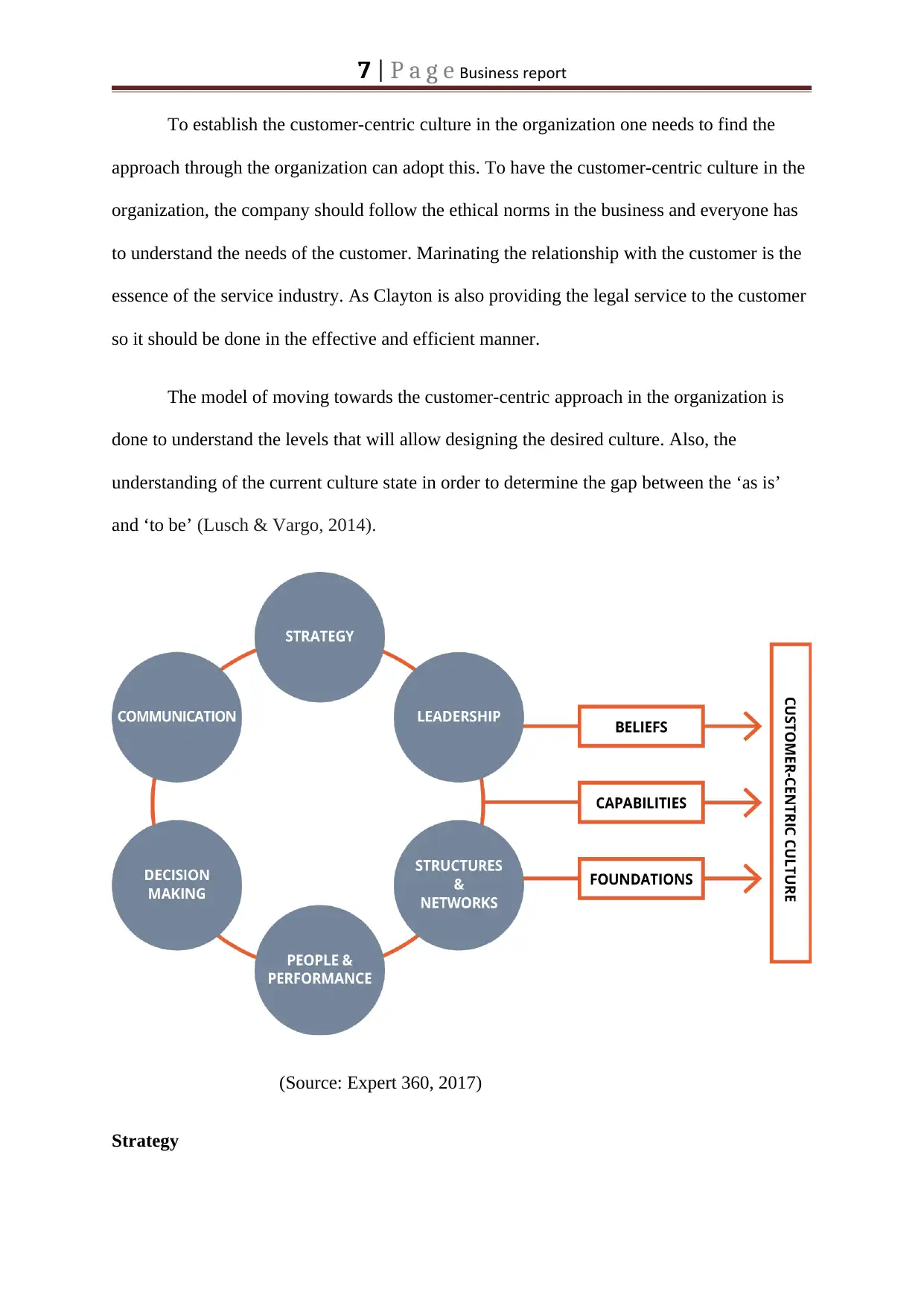
7 | P a g e Business report
To establish the customer-centric culture in the organization one needs to find the
approach through the organization can adopt this. To have the customer-centric culture in the
organization, the company should follow the ethical norms in the business and everyone has
to understand the needs of the customer. Marinating the relationship with the customer is the
essence of the service industry. As Clayton is also providing the legal service to the customer
so it should be done in the effective and efficient manner.
The model of moving towards the customer-centric approach in the organization is
done to understand the levels that will allow designing the desired culture. Also, the
understanding of the current culture state in order to determine the gap between the ‘as is’
and ‘to be’ (Lusch & Vargo, 2014).
(Source: Expert 360, 2017)
Strategy
To establish the customer-centric culture in the organization one needs to find the
approach through the organization can adopt this. To have the customer-centric culture in the
organization, the company should follow the ethical norms in the business and everyone has
to understand the needs of the customer. Marinating the relationship with the customer is the
essence of the service industry. As Clayton is also providing the legal service to the customer
so it should be done in the effective and efficient manner.
The model of moving towards the customer-centric approach in the organization is
done to understand the levels that will allow designing the desired culture. Also, the
understanding of the current culture state in order to determine the gap between the ‘as is’
and ‘to be’ (Lusch & Vargo, 2014).
(Source: Expert 360, 2017)
Strategy
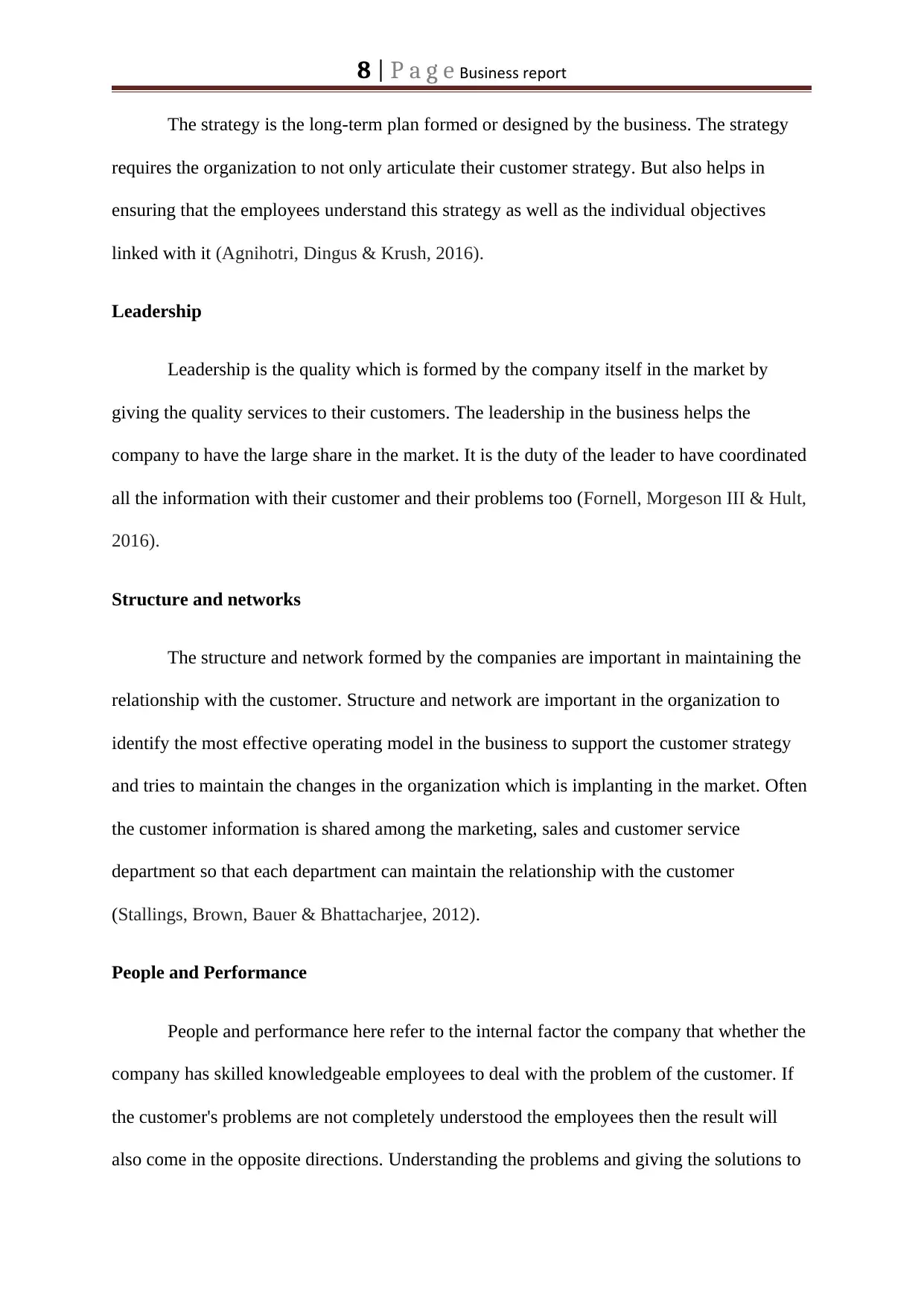
8 | P a g e Business report
The strategy is the long-term plan formed or designed by the business. The strategy
requires the organization to not only articulate their customer strategy. But also helps in
ensuring that the employees understand this strategy as well as the individual objectives
linked with it (Agnihotri, Dingus & Krush, 2016).
Leadership
Leadership is the quality which is formed by the company itself in the market by
giving the quality services to their customers. The leadership in the business helps the
company to have the large share in the market. It is the duty of the leader to have coordinated
all the information with their customer and their problems too (Fornell, Morgeson III & Hult,
2016).
Structure and networks
The structure and network formed by the companies are important in maintaining the
relationship with the customer. Structure and network are important in the organization to
identify the most effective operating model in the business to support the customer strategy
and tries to maintain the changes in the organization which is implanting in the market. Often
the customer information is shared among the marketing, sales and customer service
department so that each department can maintain the relationship with the customer
(Stallings, Brown, Bauer & Bhattacharjee, 2012).
People and Performance
People and performance here refer to the internal factor the company that whether the
company has skilled knowledgeable employees to deal with the problem of the customer. If
the customer's problems are not completely understood the employees then the result will
also come in the opposite directions. Understanding the problems and giving the solutions to
The strategy is the long-term plan formed or designed by the business. The strategy
requires the organization to not only articulate their customer strategy. But also helps in
ensuring that the employees understand this strategy as well as the individual objectives
linked with it (Agnihotri, Dingus & Krush, 2016).
Leadership
Leadership is the quality which is formed by the company itself in the market by
giving the quality services to their customers. The leadership in the business helps the
company to have the large share in the market. It is the duty of the leader to have coordinated
all the information with their customer and their problems too (Fornell, Morgeson III & Hult,
2016).
Structure and networks
The structure and network formed by the companies are important in maintaining the
relationship with the customer. Structure and network are important in the organization to
identify the most effective operating model in the business to support the customer strategy
and tries to maintain the changes in the organization which is implanting in the market. Often
the customer information is shared among the marketing, sales and customer service
department so that each department can maintain the relationship with the customer
(Stallings, Brown, Bauer & Bhattacharjee, 2012).
People and Performance
People and performance here refer to the internal factor the company that whether the
company has skilled knowledgeable employees to deal with the problem of the customer. If
the customer's problems are not completely understood the employees then the result will
also come in the opposite directions. Understanding the problems and giving the solutions to
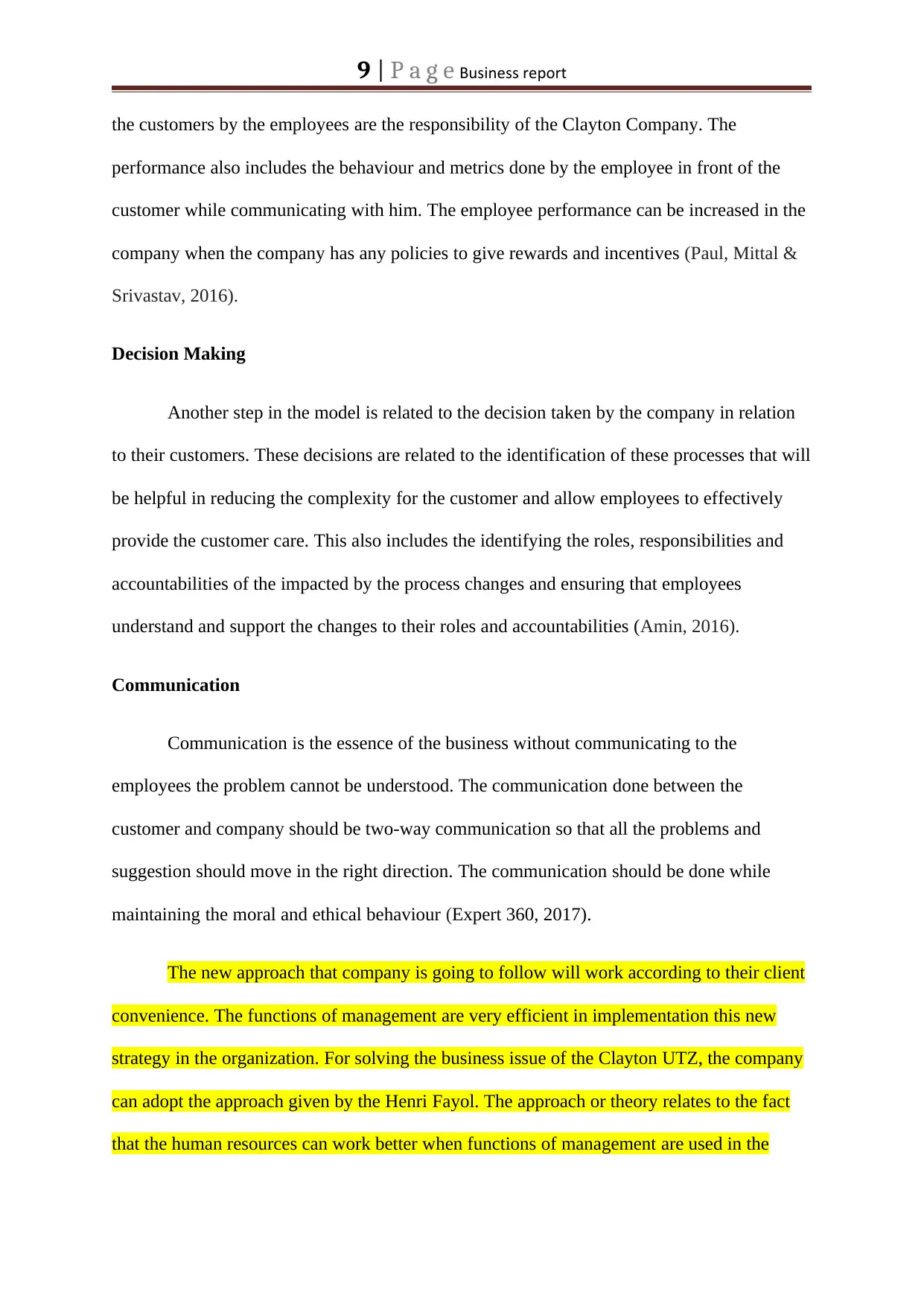
9 | P a g e Business report
the customers by the employees are the responsibility of the Clayton Company. The
performance also includes the behaviour and metrics done by the employee in front of the
customer while communicating with him. The employee performance can be increased in the
company when the company has any policies to give rewards and incentives (Paul, Mittal &
Srivastav, 2016).
Decision Making
Another step in the model is related to the decision taken by the company in relation
to their customers. These decisions are related to the identification of these processes that will
be helpful in reducing the complexity for the customer and allow employees to effectively
provide the customer care. This also includes the identifying the roles, responsibilities and
accountabilities of the impacted by the process changes and ensuring that employees
understand and support the changes to their roles and accountabilities (Amin, 2016).
Communication
Communication is the essence of the business without communicating to the
employees the problem cannot be understood. The communication done between the
customer and company should be two-way communication so that all the problems and
suggestion should move in the right direction. The communication should be done while
maintaining the moral and ethical behaviour (Expert 360, 2017).
The new approach that company is going to follow will work according to their client
convenience. The functions of management are very efficient in implementation this new
strategy in the organization. For solving the business issue of the Clayton UTZ, the company
can adopt the approach given by the Henri Fayol. The approach or theory relates to the fact
that the human resources can work better when functions of management are used in the
the customers by the employees are the responsibility of the Clayton Company. The
performance also includes the behaviour and metrics done by the employee in front of the
customer while communicating with him. The employee performance can be increased in the
company when the company has any policies to give rewards and incentives (Paul, Mittal &
Srivastav, 2016).
Decision Making
Another step in the model is related to the decision taken by the company in relation
to their customers. These decisions are related to the identification of these processes that will
be helpful in reducing the complexity for the customer and allow employees to effectively
provide the customer care. This also includes the identifying the roles, responsibilities and
accountabilities of the impacted by the process changes and ensuring that employees
understand and support the changes to their roles and accountabilities (Amin, 2016).
Communication
Communication is the essence of the business without communicating to the
employees the problem cannot be understood. The communication done between the
customer and company should be two-way communication so that all the problems and
suggestion should move in the right direction. The communication should be done while
maintaining the moral and ethical behaviour (Expert 360, 2017).
The new approach that company is going to follow will work according to their client
convenience. The functions of management are very efficient in implementation this new
strategy in the organization. For solving the business issue of the Clayton UTZ, the company
can adopt the approach given by the Henri Fayol. The approach or theory relates to the fact
that the human resources can work better when functions of management are used in the
Secure Best Marks with AI Grader
Need help grading? Try our AI Grader for instant feedback on your assignments.
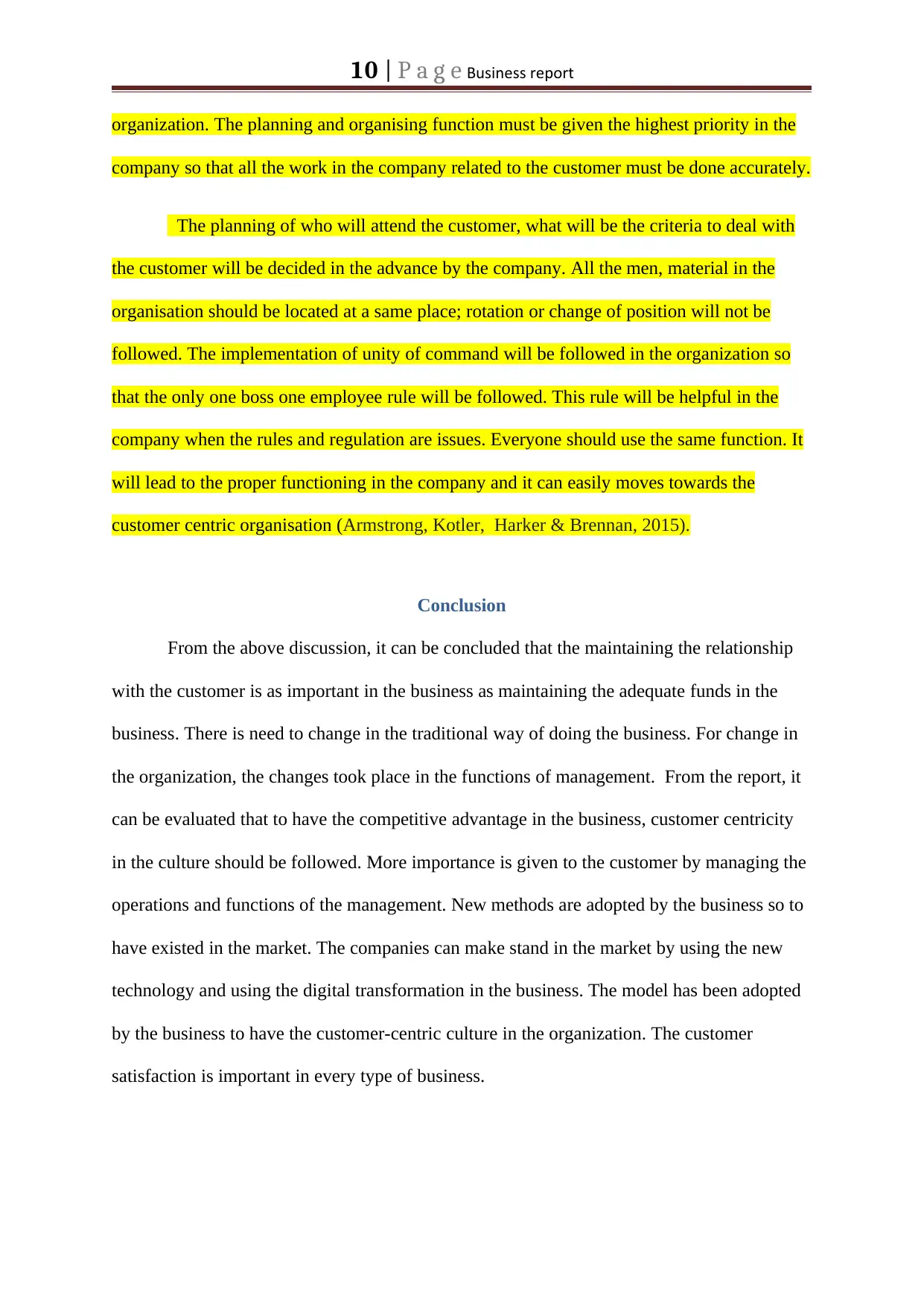
10 | P a g e Business report
organization. The planning and organising function must be given the highest priority in the
company so that all the work in the company related to the customer must be done accurately.
The planning of who will attend the customer, what will be the criteria to deal with
the customer will be decided in the advance by the company. All the men, material in the
organisation should be located at a same place; rotation or change of position will not be
followed. The implementation of unity of command will be followed in the organization so
that the only one boss one employee rule will be followed. This rule will be helpful in the
company when the rules and regulation are issues. Everyone should use the same function. It
will lead to the proper functioning in the company and it can easily moves towards the
customer centric organisation (Armstrong, Kotler, Harker & Brennan, 2015).
Conclusion
From the above discussion, it can be concluded that the maintaining the relationship
with the customer is as important in the business as maintaining the adequate funds in the
business. There is need to change in the traditional way of doing the business. For change in
the organization, the changes took place in the functions of management. From the report, it
can be evaluated that to have the competitive advantage in the business, customer centricity
in the culture should be followed. More importance is given to the customer by managing the
operations and functions of the management. New methods are adopted by the business so to
have existed in the market. The companies can make stand in the market by using the new
technology and using the digital transformation in the business. The model has been adopted
by the business to have the customer-centric culture in the organization. The customer
satisfaction is important in every type of business.
organization. The planning and organising function must be given the highest priority in the
company so that all the work in the company related to the customer must be done accurately.
The planning of who will attend the customer, what will be the criteria to deal with
the customer will be decided in the advance by the company. All the men, material in the
organisation should be located at a same place; rotation or change of position will not be
followed. The implementation of unity of command will be followed in the organization so
that the only one boss one employee rule will be followed. This rule will be helpful in the
company when the rules and regulation are issues. Everyone should use the same function. It
will lead to the proper functioning in the company and it can easily moves towards the
customer centric organisation (Armstrong, Kotler, Harker & Brennan, 2015).
Conclusion
From the above discussion, it can be concluded that the maintaining the relationship
with the customer is as important in the business as maintaining the adequate funds in the
business. There is need to change in the traditional way of doing the business. For change in
the organization, the changes took place in the functions of management. From the report, it
can be evaluated that to have the competitive advantage in the business, customer centricity
in the culture should be followed. More importance is given to the customer by managing the
operations and functions of the management. New methods are adopted by the business so to
have existed in the market. The companies can make stand in the market by using the new
technology and using the digital transformation in the business. The model has been adopted
by the business to have the customer-centric culture in the organization. The customer
satisfaction is important in every type of business.
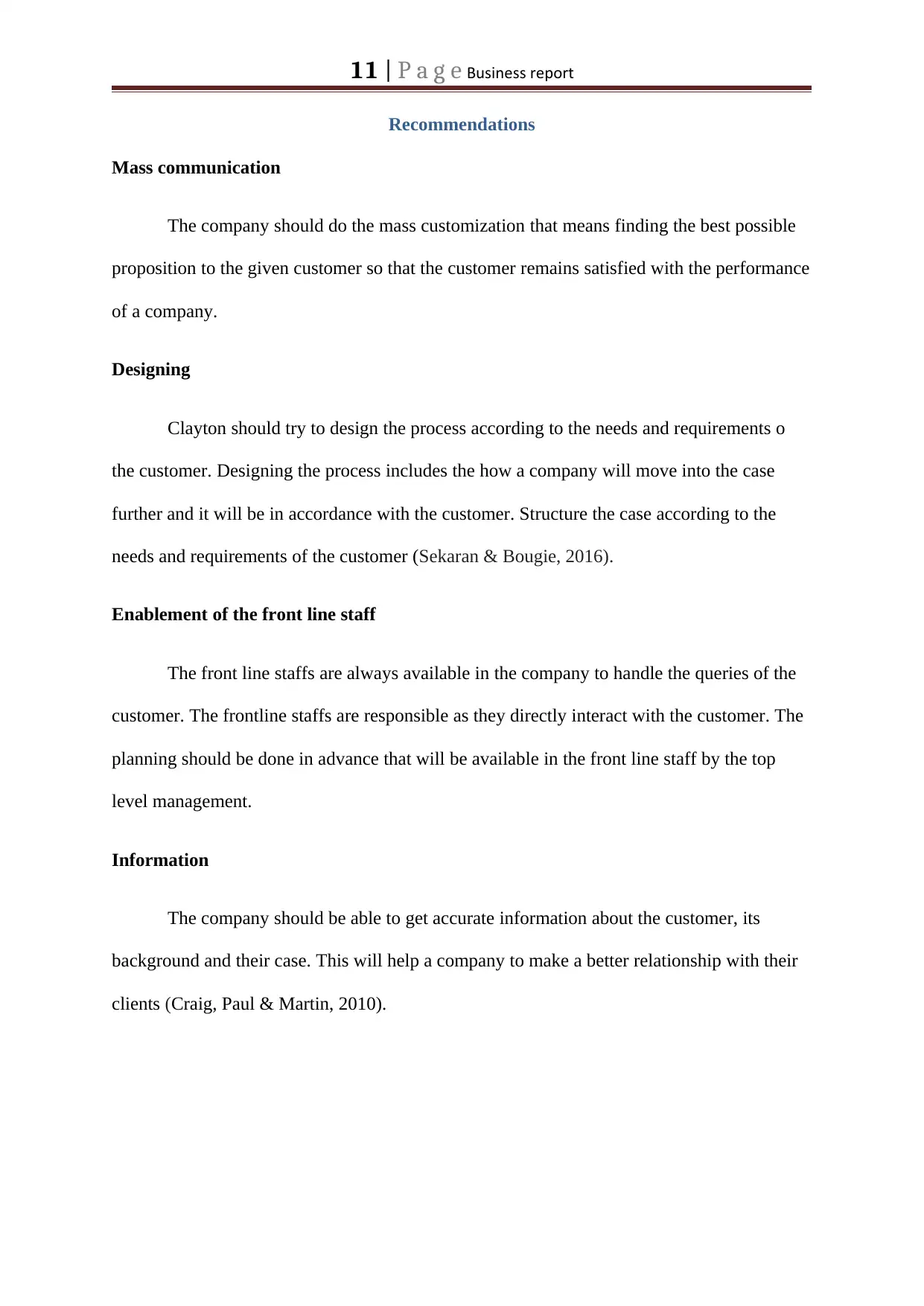
11 | P a g e Business report
Recommendations
Mass communication
The company should do the mass customization that means finding the best possible
proposition to the given customer so that the customer remains satisfied with the performance
of a company.
Designing
Clayton should try to design the process according to the needs and requirements o
the customer. Designing the process includes the how a company will move into the case
further and it will be in accordance with the customer. Structure the case according to the
needs and requirements of the customer (Sekaran & Bougie, 2016).
Enablement of the front line staff
The front line staffs are always available in the company to handle the queries of the
customer. The frontline staffs are responsible as they directly interact with the customer. The
planning should be done in advance that will be available in the front line staff by the top
level management.
Information
The company should be able to get accurate information about the customer, its
background and their case. This will help a company to make a better relationship with their
clients (Craig, Paul & Martin, 2010).
Recommendations
Mass communication
The company should do the mass customization that means finding the best possible
proposition to the given customer so that the customer remains satisfied with the performance
of a company.
Designing
Clayton should try to design the process according to the needs and requirements o
the customer. Designing the process includes the how a company will move into the case
further and it will be in accordance with the customer. Structure the case according to the
needs and requirements of the customer (Sekaran & Bougie, 2016).
Enablement of the front line staff
The front line staffs are always available in the company to handle the queries of the
customer. The frontline staffs are responsible as they directly interact with the customer. The
planning should be done in advance that will be available in the front line staff by the top
level management.
Information
The company should be able to get accurate information about the customer, its
background and their case. This will help a company to make a better relationship with their
clients (Craig, Paul & Martin, 2010).
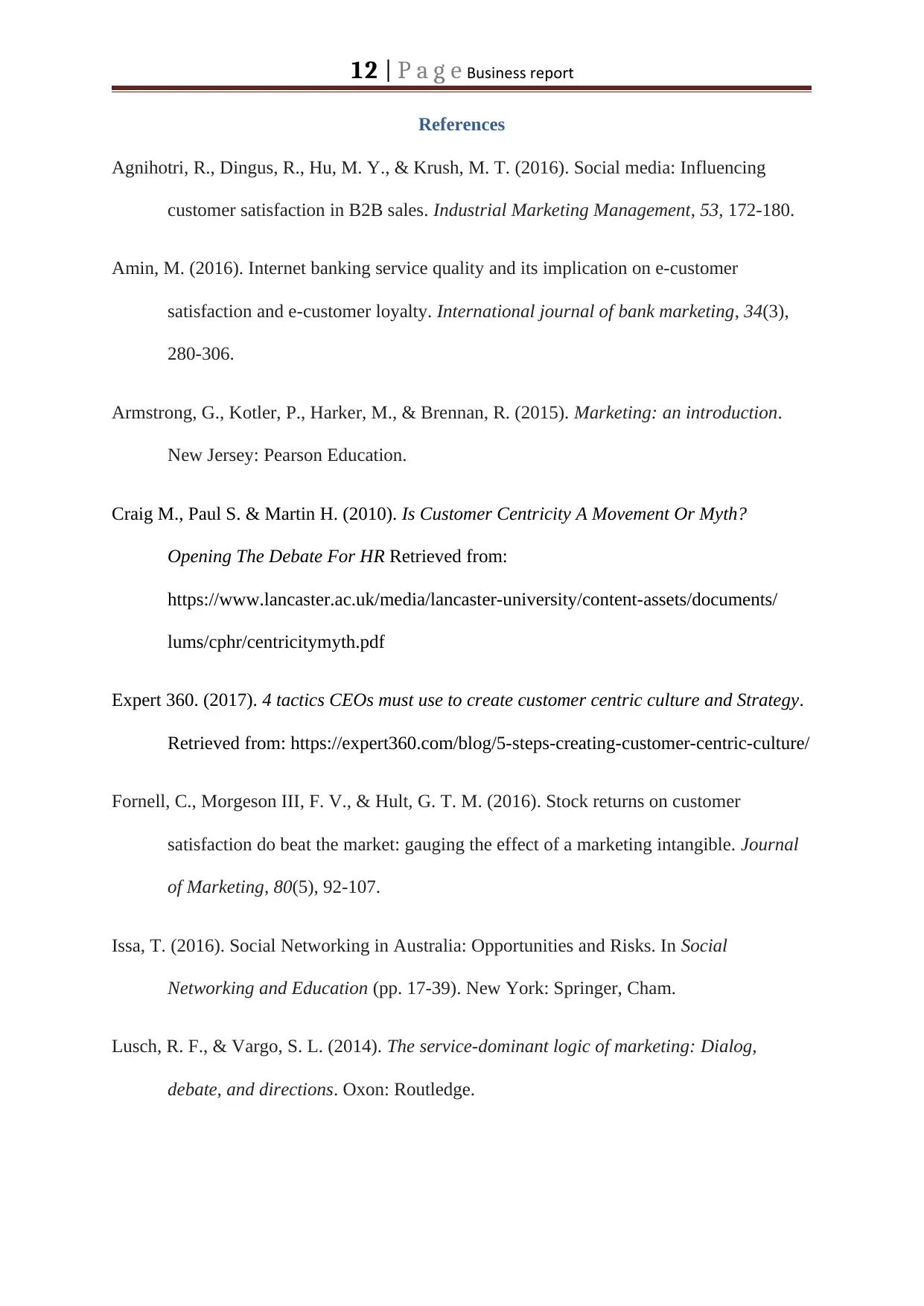
12 | P a g e Business report
References
Agnihotri, R., Dingus, R., Hu, M. Y., & Krush, M. T. (2016). Social media: Influencing
customer satisfaction in B2B sales. Industrial Marketing Management, 53, 172-180.
Amin, M. (2016). Internet banking service quality and its implication on e-customer
satisfaction and e-customer loyalty. International journal of bank marketing, 34(3),
280-306.
Armstrong, G., Kotler, P., Harker, M., & Brennan, R. (2015). Marketing: an introduction.
New Jersey: Pearson Education.
Craig M., Paul S. & Martin H. (2010). Is Customer Centricity A Movement Or Myth?
Opening The Debate For HR Retrieved from:
https://www.lancaster.ac.uk/media/lancaster-university/content-assets/documents/
lums/cphr/centricitymyth.pdf
Expert 360. (2017). 4 tactics CEOs must use to create customer centric culture and Strategy.
Retrieved from: https://expert360.com/blog/5-steps-creating-customer-centric-culture/
Fornell, C., Morgeson III, F. V., & Hult, G. T. M. (2016). Stock returns on customer
satisfaction do beat the market: gauging the effect of a marketing intangible. Journal
of Marketing, 80(5), 92-107.
Issa, T. (2016). Social Networking in Australia: Opportunities and Risks. In Social
Networking and Education (pp. 17-39). New York: Springer, Cham.
Lusch, R. F., & Vargo, S. L. (2014). The service-dominant logic of marketing: Dialog,
debate, and directions. Oxon: Routledge.
References
Agnihotri, R., Dingus, R., Hu, M. Y., & Krush, M. T. (2016). Social media: Influencing
customer satisfaction in B2B sales. Industrial Marketing Management, 53, 172-180.
Amin, M. (2016). Internet banking service quality and its implication on e-customer
satisfaction and e-customer loyalty. International journal of bank marketing, 34(3),
280-306.
Armstrong, G., Kotler, P., Harker, M., & Brennan, R. (2015). Marketing: an introduction.
New Jersey: Pearson Education.
Craig M., Paul S. & Martin H. (2010). Is Customer Centricity A Movement Or Myth?
Opening The Debate For HR Retrieved from:
https://www.lancaster.ac.uk/media/lancaster-university/content-assets/documents/
lums/cphr/centricitymyth.pdf
Expert 360. (2017). 4 tactics CEOs must use to create customer centric culture and Strategy.
Retrieved from: https://expert360.com/blog/5-steps-creating-customer-centric-culture/
Fornell, C., Morgeson III, F. V., & Hult, G. T. M. (2016). Stock returns on customer
satisfaction do beat the market: gauging the effect of a marketing intangible. Journal
of Marketing, 80(5), 92-107.
Issa, T. (2016). Social Networking in Australia: Opportunities and Risks. In Social
Networking and Education (pp. 17-39). New York: Springer, Cham.
Lusch, R. F., & Vargo, S. L. (2014). The service-dominant logic of marketing: Dialog,
debate, and directions. Oxon: Routledge.
Paraphrase This Document
Need a fresh take? Get an instant paraphrase of this document with our AI Paraphraser
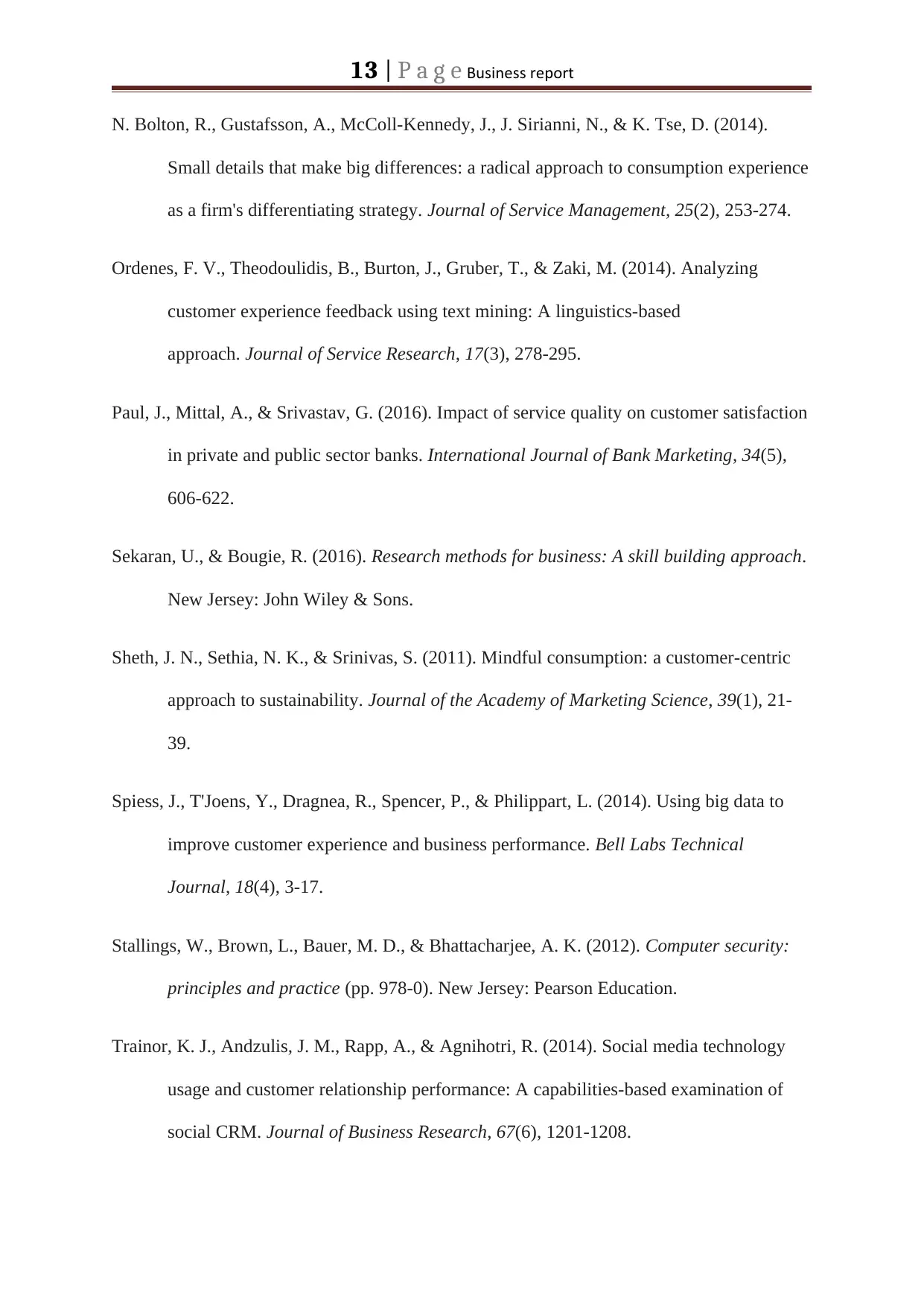
13 | P a g e Business report
N. Bolton, R., Gustafsson, A., McColl-Kennedy, J., J. Sirianni, N., & K. Tse, D. (2014).
Small details that make big differences: a radical approach to consumption experience
as a firm's differentiating strategy. Journal of Service Management, 25(2), 253-274.
Ordenes, F. V., Theodoulidis, B., Burton, J., Gruber, T., & Zaki, M. (2014). Analyzing
customer experience feedback using text mining: A linguistics-based
approach. Journal of Service Research, 17(3), 278-295.
Paul, J., Mittal, A., & Srivastav, G. (2016). Impact of service quality on customer satisfaction
in private and public sector banks. International Journal of Bank Marketing, 34(5),
606-622.
Sekaran, U., & Bougie, R. (2016). Research methods for business: A skill building approach.
New Jersey: John Wiley & Sons.
Sheth, J. N., Sethia, N. K., & Srinivas, S. (2011). Mindful consumption: a customer-centric
approach to sustainability. Journal of the Academy of Marketing Science, 39(1), 21-
39.
Spiess, J., T'Joens, Y., Dragnea, R., Spencer, P., & Philippart, L. (2014). Using big data to
improve customer experience and business performance. Bell Labs Technical
Journal, 18(4), 3-17.
Stallings, W., Brown, L., Bauer, M. D., & Bhattacharjee, A. K. (2012). Computer security:
principles and practice (pp. 978-0). New Jersey: Pearson Education.
Trainor, K. J., Andzulis, J. M., Rapp, A., & Agnihotri, R. (2014). Social media technology
usage and customer relationship performance: A capabilities-based examination of
social CRM. Journal of Business Research, 67(6), 1201-1208.
N. Bolton, R., Gustafsson, A., McColl-Kennedy, J., J. Sirianni, N., & K. Tse, D. (2014).
Small details that make big differences: a radical approach to consumption experience
as a firm's differentiating strategy. Journal of Service Management, 25(2), 253-274.
Ordenes, F. V., Theodoulidis, B., Burton, J., Gruber, T., & Zaki, M. (2014). Analyzing
customer experience feedback using text mining: A linguistics-based
approach. Journal of Service Research, 17(3), 278-295.
Paul, J., Mittal, A., & Srivastav, G. (2016). Impact of service quality on customer satisfaction
in private and public sector banks. International Journal of Bank Marketing, 34(5),
606-622.
Sekaran, U., & Bougie, R. (2016). Research methods for business: A skill building approach.
New Jersey: John Wiley & Sons.
Sheth, J. N., Sethia, N. K., & Srinivas, S. (2011). Mindful consumption: a customer-centric
approach to sustainability. Journal of the Academy of Marketing Science, 39(1), 21-
39.
Spiess, J., T'Joens, Y., Dragnea, R., Spencer, P., & Philippart, L. (2014). Using big data to
improve customer experience and business performance. Bell Labs Technical
Journal, 18(4), 3-17.
Stallings, W., Brown, L., Bauer, M. D., & Bhattacharjee, A. K. (2012). Computer security:
principles and practice (pp. 978-0). New Jersey: Pearson Education.
Trainor, K. J., Andzulis, J. M., Rapp, A., & Agnihotri, R. (2014). Social media technology
usage and customer relationship performance: A capabilities-based examination of
social CRM. Journal of Business Research, 67(6), 1201-1208.
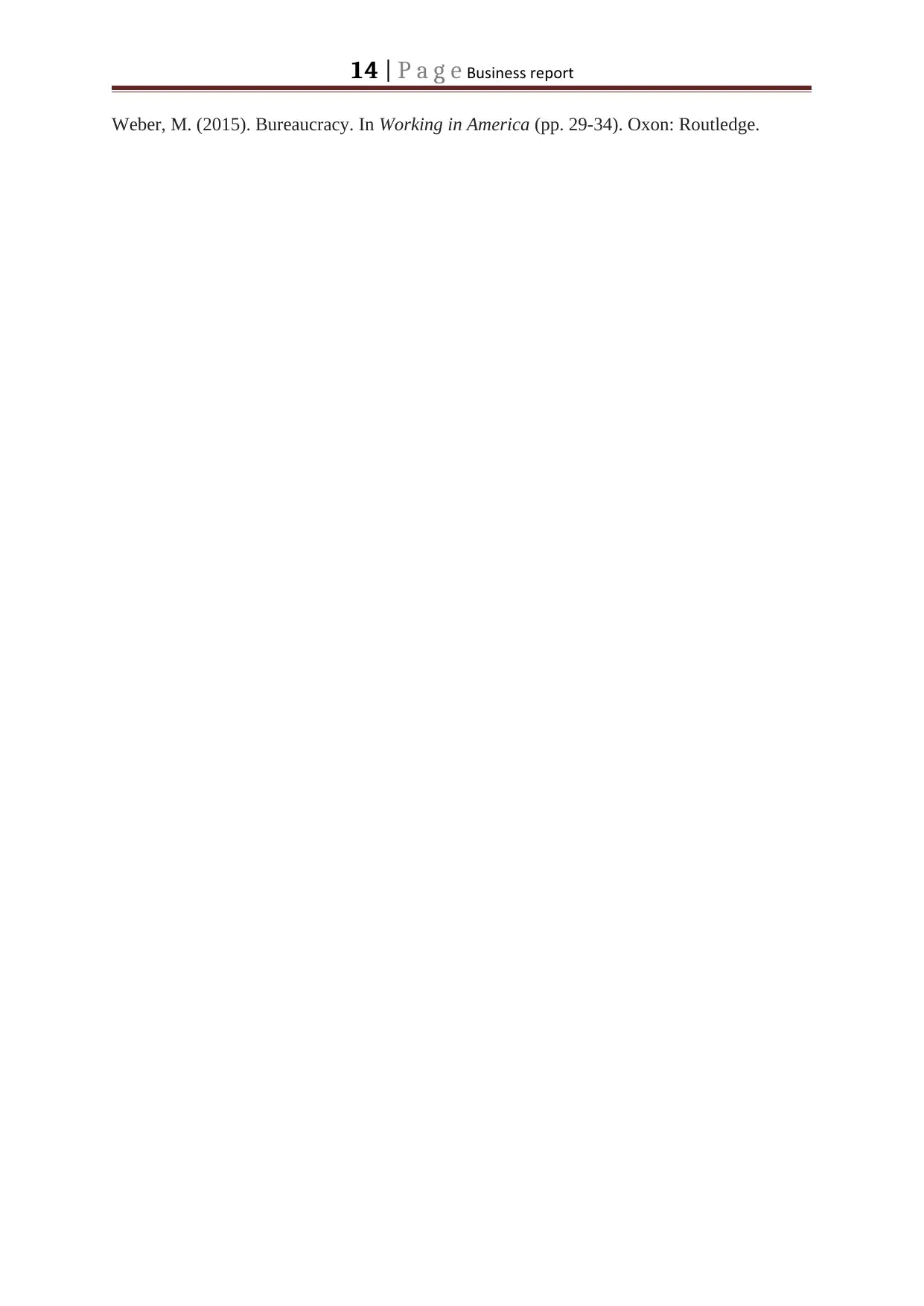
14 | P a g e Business report
Weber, M. (2015). Bureaucracy. In Working in America (pp. 29-34). Oxon: Routledge.
Weber, M. (2015). Bureaucracy. In Working in America (pp. 29-34). Oxon: Routledge.
1 out of 15
Related Documents
Your All-in-One AI-Powered Toolkit for Academic Success.
+13062052269
info@desklib.com
Available 24*7 on WhatsApp / Email
![[object Object]](/_next/static/media/star-bottom.7253800d.svg)
Unlock your academic potential
© 2024 | Zucol Services PVT LTD | All rights reserved.




